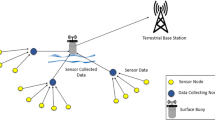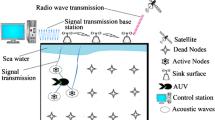Abstract
Energy is the significant limitation in underwater sensor arrangement. In Underwater sensor organization, the sink node uses high energy in charge of sending information from nodes that are more remote away. The battery depleted in a brief span. The suggested technique productively diminishes the energy utilization in Mobicast steering convention in Underwater Sensor Networks (USN). Underwater Sensor Network is broadly utilized for checking and assembling information in a self-sufficient form. Since sensors are little and power obliged gadgets, it is the most vital to reduce the energy utilization. The autonomous Underwater vehicle (AUV) goes along a way that has been characterized by the client to bring the detecting information from a Underwater sensor node. The Mobicast Routing Protocol for Underwater Sensor Networks is utilized to manage the cost of a spatiotemporal answer for the Underwater Sensor Networks and furthermore it gives an effective information gathering and a energy sparing directing convention for the USN. The researchers suggest Node Degree Algorithm for improving life span of varied Under Water Sensor systems with Time Differential on Arrival (TDOA), the TDOA saves the energy use of sensor nodes. A considerable measure of particularly, TDOA decreases energy utilization and will expand network life time, as contrasted and existing calculations. To discover mobility the GaussMarkov versatility model is utilized. The suggested techniques utilize a static sensor node which gathers the accumulated information from different nodes in its Zone of Reference (ZOR) area and send this gathered information to AUV while it enters 3-D ZOR, in this way lessening the energy utilized for transmission. Once the static node losses the energy in the bunch another node in the ZOR group which has high energy with fewer portability as well as higher node degree would be selected as a static node. Simulation results and data analysis shows the performance of proposed protocol is more efficient in terms of overall performance as compared to other existing routing protocols for Underwater Wireless Sensor Networks and it was simulated in NS2 simulation software environment. This research achieves to minimize power consumption, response time and avoid overload finally it increases the throughput and Network lifetime.











Similar content being viewed by others
References
Wahid, A., Lee, S., et al. (2014). MRP: A localization free multi layered routing protocol for underwater wireless sensor networks. Wireless Personal Communications, 77(4), 2997–3012.
Mothghare, A. L. (2017). Architecture and issues in Delay Tolerant Network’S (DTNs) Security. In International conference on recent trends in engineering science and technology (ICRTEST 2017), Vol. 5, No. 1 (Special Issue 21–22 January 2017). ISSN: 2321-8169.
Yu, H., Yao, N., & Liu, J. (2014). An adaptive routing protocol in underwater sparse acoustic sensor networks. Ad Hoc Networks, 34, 121–143.
Hu, T., & Fei, Y. (2010). Qelar: A machine-learning-based adaptive routing protocol for energy efficient and lifetime-extended underwater sensor networks. IEEE Transactions on Mobile Computing, 9(6), 796–809.
Wang, Y. (2014). Three-dimensional wireless sensor networks: Geometric approaches for topology and routing design. The art of wireless sensor networks (pp. 367–409). Berlin: Springer.
Khan, J. U., & Cho, H. S. (2015). A distributed data-gathering protocol using AUV in underwater sensor networks. Sensors, 15, 19331–19350. https://doi.org/10.3390/s150819331.
Chen, Y. S., Ann, S. Y., & Lin, Y. W. (2010). Hve-mobicast: A hierarchical-variant-egg-based mobicast routing protocol for sensornets. Telecommunication Systems, 41(2), 121–140.
Safavi, S. M., Meybodi, M. R., & Esnaashari, M. (2014). Learning automata based face-aware mobicast. Wireless Personal Communications, 77, 1923–1933. https://doi.org/10.1007/s11277-014-1616-3.
Kartha, J. J., & Jacob, L. (2017). Network lifetime-aware data collection in underwater sensor networks for delay-tolerant applications, Vol. 42, No. 10, Indian Academy of Sciences, pp. 1645–1664. https://doi.org/10.1007/s12046-017-0713-x.
Lloret, J. (2013). Underwater sensor nodes and networks. Sensors, 13, 11782–11796. https://doi.org/10.3390/s130911782.
Deepak, P. S., Gowtham, S., Manuprasad, K. N., & Remya Nair, T. (2018). Impact of energy efficient routing on the performance of proactive, reactive and hybrid routing protocols of MANET. International Journal of Pure and Applied Mathematics, 119(10), 957–965.
Jain, S., & Jain, S. (2014). Energy efficient maximum lifetime ad-hoc routing (EEMLAR). International Journal of Computer networks and Wireless Communications., 2(4), 450–455.
Pantazis, N. A., Nikolidakis, S. A., & Vergados, D. D. (2013). Energy-efficient routing protocols in wireless sensor networks: A survey. IEEE Communications Surveys & Tutorials, 15(2), 551–591.
Sanchez, A., Blanc, S., Yuste, P., & Serrano, J. J. (2011). A low cost and high efficient acoustic modem for underwater sensor networks. In OCEANS, IEEE, Spain.
Wang, K., Gao, H., Xu, X., Jiang, J., & Yue, D. (2016). An energy-efficient reliable data transmission scheme for complex environmental monitoring in underwater acoustic sensor networks. IEEE Sensors Journal, 16(11), 4051.
Hsu, C. C., Liu, H. H., Gómez, J. L. G., & Chou, C. F. (2015). Delay-sensitive opportunistic routing for underwater sensor networks. IEEE Sensors Journal, 15(11), 3436–6432.
Gulbahar, B. (2016). Network topology modulation for energy and data transmission in internet of magneto-inductive things. In Proceedings of IEEE GLOBECOM 2016 first international workshop on the internet of everything (IoE).
Shu, Y., Shin, K. G., Chen, J., & Sun, Y. (2017). Joint energy replenishment and operation scheduling in wireless rechargeable sensor networks. IEEE Transactions on Industrial Informatics, 13(1), 125–134.
Harb, H., Makhoul, A., & Couturier, R. (2015). An enhanced K-means and ANOVA-based clustering approach for similarity aggregation in underwater wireless sensor networks. IEEE Sensors Journal, 15(10), 5483–5493.
Gomathi, R. M., & Martin Leo Manickam, J. (2015). Energy preserved mobicast routing prorocol with static node for underwater acoustic sensor network. In Proceedings of IEEE international conference on innovation, information in computing technology (ICIICT), pp. 1–9.
Sivasangari, A., & Martin Leo Manickam, J. (2014). A light weight cryptography analysis for wireless based healthcare applications. Journal of Computer Science, 10(5), 2088–2094.
Gomathi, R. M., & Martin Leo Manickam, J. (2018). Energy efficient shortest path routing protocol for underwater acoustic wireless sensor network. Wireless Personal Communications, 98(1), 843–856.
Acknowledgements
We are thankful to the management of Sathyabama Institute of Science and Technology for providing us all the necessary facilities required for this research work.
Author information
Authors and Affiliations
Corresponding author
Additional information
Publisher's Note
Springer Nature remains neutral with regard to jurisdictional claims in published maps and institutional affiliations.
Rights and permissions
About this article
Cite this article
Gomathi, R.M., Manickam, J.M.L. Energy Efficient Static Node Selection in Underwater Acoustic Wireless Sensor Network. Wireless Pers Commun 107, 709–727 (2019). https://doi.org/10.1007/s11277-019-06277-2
Published:
Issue Date:
DOI: https://doi.org/10.1007/s11277-019-06277-2




